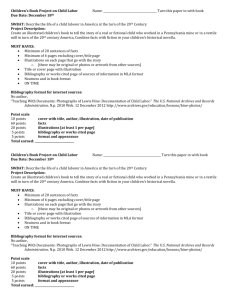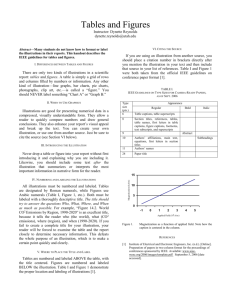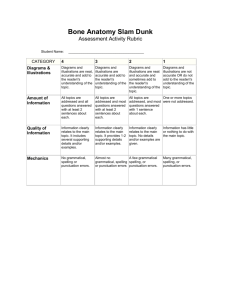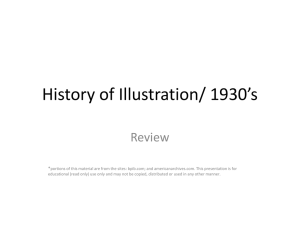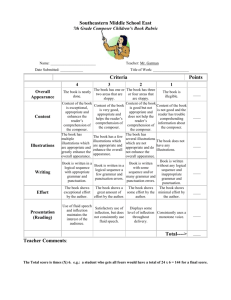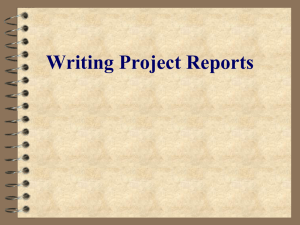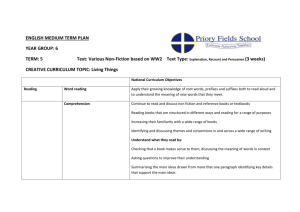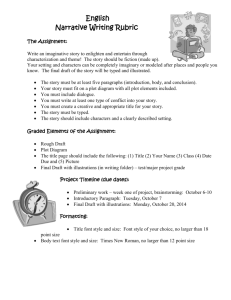Medieval Europe Storybook
advertisement
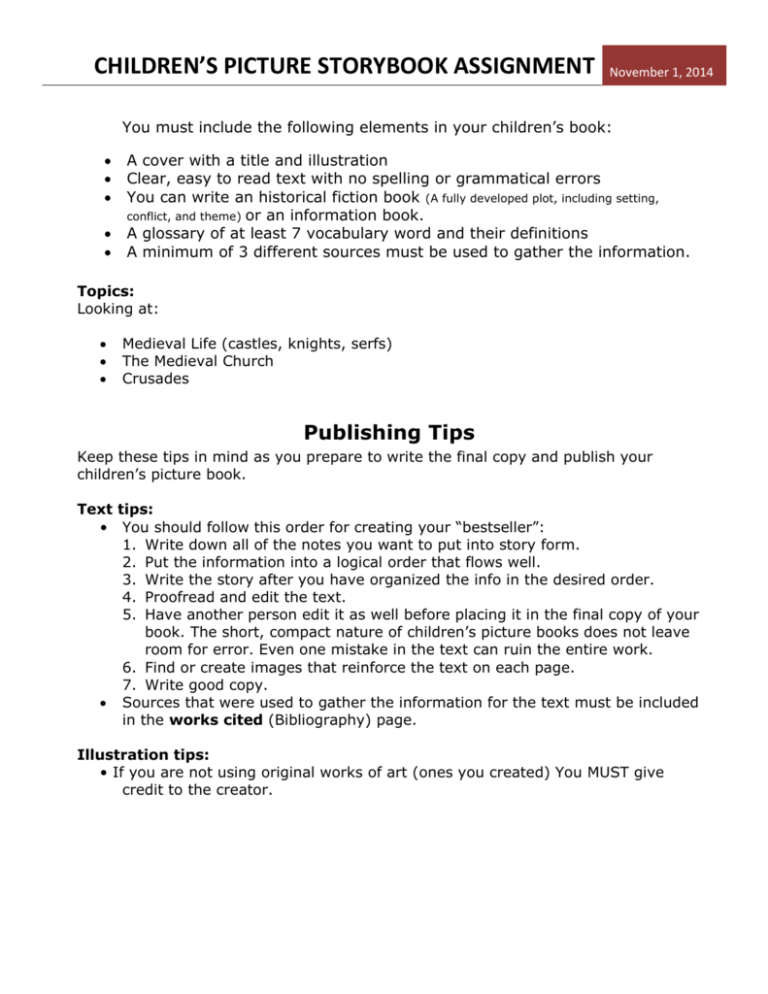
CHILDREN’S PICTURE STORYBOOK ASSIGNMENT November 1, 2014 You must include the following elements in your children’s book: A cover with a title and illustration Clear, easy to read text with no spelling or grammatical errors You can write an historical fiction book (A fully developed plot, including setting, conflict, and theme) or an information book. A glossary of at least 7 vocabulary word and their definitions A minimum of 3 different sources must be used to gather the information. Topics: Looking at: Medieval Life (castles, knights, serfs) The Medieval Church Crusades Publishing Tips Keep these tips in mind as you prepare to write the final copy and publish your children’s picture book. Text tips: • You should follow this order for creating your “bestseller”: 1. Write down all of the notes you want to put into story form. 2. Put the information into a logical order that flows well. 3. Write the story after you have organized the info in the desired order. 4. Proofread and edit the text. 5. Have another person edit it as well before placing it in the final copy of your book. The short, compact nature of children’s picture books does not leave room for error. Even one mistake in the text can ruin the entire work. 6. Find or create images that reinforce the text on each page. 7. Write good copy. Sources that were used to gather the information for the text must be included in the works cited (Bibliography) page. Illustration tips: • If you are not using original works of art (ones you created) You MUST give credit to the creator. CHILDREN’S PICTURE STORYBOOK ASSIGNMENT November 1, 2014 Grading Rubric for the Children’s Picture Storybook 6 Cover 4 2 Title and illustration on cover clearly relate to the story and entice readers to pick up the book. There are no grammar or spelling errors anywhere in the work. Title and illustration clearly relate to the story. Title and illustration are poorly done or do not relate to the story. Two-four grammar or spelling errors occur in the work. Five or more grammar or spelling errors occur in the work. Story Development The story flows very, includes a great amount of valuable factual information on the topic and is clearly developed. The main idea of the story is developed throughout the book. The story is not clearly developed. It goes off topic or has limited information. The Illustrations’ Support of the story The illustrations help present the plot throughout all areas in the work. The story flows well, however there could be more information on the topic. The main idea of the book is maintained throughout the book. There may be some unnecessary information. The illustrations help present the plot in a majority of areas throughout the work. Length The length is not fewer than 10 pages including cover page and works cited. At least 7 vocabulary words are included from the original story and are defined in a glossary. Student used more than the required number of sources and all sources are cited correctly on a works cited page. The length is not fewer than 8 pages. Required pages may have been missing. At least 5 vocabulary words are included from the original story and are included in a glossary. Student cited sources used, however they were not cited correctly. The length is fewer than 6 pages. Conventions x2 (Grammar and Spelling) Glossary Citing NOTES: The illustrations help present the plot in only a minority of areas throughout the work. Fewer than 4 vocabulary words are included and defined in a glossary. No works cited page was included with the book. /48 CHILDREN’S PICTURE STORYBOOK ASSIGNMENT November 1, 2014 Tips for Writing a Children’s Picture Storybook Definition Children’s Picture Storybook—A work written for children that uses both text and illustrations to present a simple plot. Format Picture storybooks are very visual with limited text (max. 30 words per page). The picture that is on the page reinforces the text that is on the page. Text • The text of a children’s book should be organized into simple sentences and short paragraphs. • The use of active verbs will keep the story vivid in the reader’s mind. • Children’s book authors employ literary tools to help make the story more vivid in the reader’s mind. Rhythm, alliteration, repetition, refrains, onomatopoeia, simile, personification, rhyme, and imagery are commonly used devices. • Consider ending each page with a question or other method that sparks the reader’s curiosity for what will happen next. • Repeating a phrase throughout the story will help hold your reader’s attention. • Use a question at the end of the page to help move your reader to the next page. Illustrations • Some picture books have an illustration on the front cover that presents the main conflict or point of the story. • The illustrations are usually created after the text has been written. • Illustrations serve as a partner to the text.
